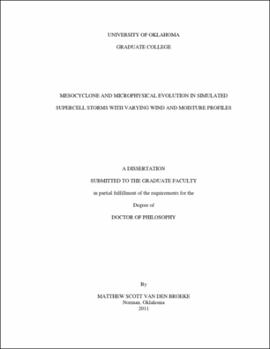| dc.contributor.advisor | Straka, Jerry M | |
| dc.creator | Van Den Broeke, Matthew | |
| dc.date.accessioned | 2019-04-27T21:38:50Z | |
| dc.date.available | 2019-04-27T21:38:50Z | |
| dc.date.issued | 2011 | |
| dc.identifier | 9947319302042 | |
| dc.identifier.uri | https://hdl.handle.net/11244/319256 | |
| dc.description.abstract | As a high-impact convective mode, supercell thunderstorms have frequently been studied observationally and numerically. Two areas of study have focused on understanding mesocyclone evolution given a varying environmental wind profile, and learning about microphysical distributions within supercells. In the research presented here, simulations are run over a broad parameter space of wind profiles, and with a smaller number of profiles representative of environmental drying at mid and upper levels. Mesocyclone evolution is compared across the parameter space of wind profiles, and between simulations with liquid and ice microphysics. Effects of the wind profile and moisture variations are explored on microphysical distributions. Subsequently, possible effects of these microphysical variations on supercell evolution are considered. | |
| dc.description.abstract | When using detailed ice microphysics with this particular choice of thermodynamic profile, mesocyclone evolution is shown to be more frequently non-occluding cyclic with no steady non-cycling storms. Storms with detailed ice microphysics are shown to have warmer cold pools, and to more rapidly concentrate vertical vorticity at low levels. The single feature found to most influence low-level mesocyclone structure was an RFD westerly surge proceeding from the echo appendage and moving eastward into the updraft region. This westerly surge often produced a new or strengthened updraft pulse, often caused a cycling process to ensue, and was the southern limit of the primary near-surface vertical vorticity maximum. Quantity and spatial distribution of warm rain and hail from frozen drops may affect downdraft temperature and thus strength of this RFD surge. Associations are explored between maximum warm rain mixing ratio and variables related to RFD intensity and near-surface vertical vorticity. Mid- and upper-level drying reduced content of small ice particles and warm rain, while increasing content of hail from frozen drops. Bursts of warm rain and hail from frozen drops were often associated with increasing near-surface vertical vorticity, apparently related to an intensified RFD westerly surge. | |
| dc.format.extent | 134 pages | |
| dc.format.medium | application.pdf | |
| dc.language | en_US | |
| dc.relation.requires | Adobe Acrobat Reader | |
| dc.subject | Mesometeorology | |
| dc.subject | Tornadoes | |
| dc.subject | Wind profiles | |
| dc.subject | Thunderstorms | |
| dc.title | Mesocyclone and Microphysical Evolution in Simulated Supercell Storms with Varying Wind and Moisture Profiles | |
| dc.type | text | |
| dc.type | document | |
| dc.thesis.degree | Ph.D. | |
| ou.group | College of Atmospheric & Geographic Sciences::School of Meteorology | |
